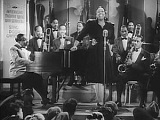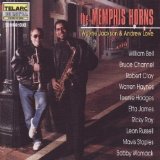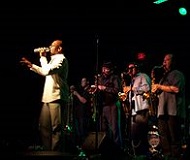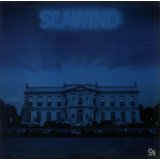Our next contributor plays saxophone with Southside Johnny and The Asbury Jukes but also released a strikingly good album this year as part of the New York Horns which is one of Allan’s albums of the year. When we asked him for a High Fives piece, here’s what he came up with. We think you’ll like this.
5 Horn Sections That Changed My Life
As a saxophone player, one of my absolute favorite ways to make music is with other horn players. Give me a trumpet or two, a couple of other saxophone players and a trombone to add some love, and you’ve got a recipe for a whole lotta fun. If the rhythm section is the meat and potatoes, and the vocalist is dessert, then the horn section is the salt. We bring out all the other flavors and make everything oh so much sweeter.
In thinking about the subject matter for this best-of list, it quickly dawned on me that I had MANY more than five examples that I could draw upon to make my point. So many that I almost gave up! After some careful consideration though, here’s five of the horn sections that have changed my life through their contributions to the music:
THE swingin-est band in the history of jazz. Count Basie’s band emerged in the 1930’s in Kansas City, and became the de facto definition of foot-stomping swing with their penchant for shouting blues, riffing head arrangements, and an infectious groove that just made you want to dance. The jazz traditions of “riffing” and “head arrangements”, while not originating with the Basie band, were certainly developed and forwarded onward by the band. Many of the riffs, licks and phrases that you will hear modern horn sections play can trace some or part of their lineage back to the Basie band. Check out “The Atomic Mr. Basie” (1957) and “Count Basie Swings, Joe Williams Sings” (1956). Two of my all time favorite Basie albums.
James Brown redefined popular music. He also redefined the role of the horn section in popular music. Prior to his influence, horns would generally have a more melodic role – playing melodies and generally being in a “lead” role. The late swing and early jump blues bands often were led by horn players and under the vocals the horns played a large supporting role, remaining a mostly harmonic underpinning. James changed all that. The horn section under James Brown became another rhythmic instrument, driving and propelling the groove. With snapping rhythmic pulses and repeating motifs, the horn section was another texture in the rhythm section, adding propulsion and rhythmic intensity. Check out “Mother Popcorn”, “Super Bad”, “Soul Power” and “Cold Sweat” for classic examples. The JB Horns (Maceo Parker, Fred Wesley, Alfred “Pee Wee” Ellis) also were a fixture of P-Funk and Bootsie’s (Collins) Rubber Band, as the Horny Horns.
Growing up in North Carolina, in the southern United States, it was inevitable that I was exposed to the music coming out of Memphis, Tennessee and especially STAX Records. Wayne Jackson and Andrew Love, aka the Memphis Horns, are one of the most recorded horn sections in history. If you’ve heard “Dock Of The Bay”, “Soul Man”, “Hold On I’m Comin’”, “Suspicious Minds”, “Sweet Caroline”, “Takin’ It To The Streets”, “Let’s Stay Together”, “Born Under A Bad Sign”, “Knock On Wood” (and countless other hits), then you’ve heard the Memphis Horns. They appeared on virtually every STAX recording, backing Otis Redding, Sam & Dave, Eddie Floyd, Carla & Rufus Thomas and an endless list of others. Not only were they a staple of the Memphis scene but could also be found as part of the Muscle Shoals scene, and on recordings with Aretha Franklin and Wilson Pickett.
No modern horn player that plays funk, soul or R&B hasn’t heard of or spent time studying TOP. Bursting onto the scene in Oakland, CA in 1968, Tower saw its peak success from 1973 to 1974. The band continues to tour extensively to this day, playing hundreds of shows every year across the world. The horn section has been featured on countless recordings by artists as diverse as Little Feat, Graham Central Station, The Monkees, Santana, Elton John, John Lee Hooker, Rufus, Rod Stewart, Huey Lewis and the News, and Aerosmith and has come to define a punchy, modern and funky style of writing and performing for horns. Check out “Tower of Power” (1973) and “Back to Oakland” (1974) for the definitive TOP experience.
While not a horn section unto himself, Jerry Hey has probably written more horn arrangements for hit songs and albums than anyone else in the business. As part of the Seawind Horns, Jerry was brought to the attention of Quincy Jones. That relationship led to Jerry’s writing for some of the biggest names in the industry. His credits as an arranger include albums from Michael Jackson, Brothers Johnson, Donna Summer, Rufus, George Benson, Patti Austin, James Ingram, Frank Sinatra, Barbra Streisand, Earth, Wind and Fire , Al Jarreau, Chaka Khan, and the list goes on… Two of my favorite albums that feature Jerry’s writing (and the Jerry Hey Horns) extensively are Al Jarreau’s “Jarreau” and “High Crime” (Check out “Imagination”!) and likely my all time favorite Jerry Hey arrangement (and performance) is from Michael Jackson’s “Workin’ Day And Night” (“Off The Wall”).
I could go on and on… there are so many great horn sections, players and writers out there, making incredible music. Hopefully this list will give you some food for thought and a good place to begin to explore the horn section legacy. Enjoy!
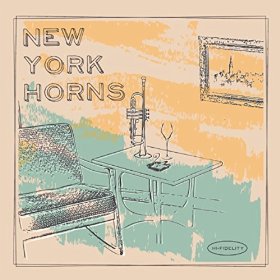 It’s relatively easy to record an album these days; you can do it at home or maybe in a studio and it won’t cost you the earth. You can organise your own distribution online or at live shows; you won’t get rich but you will get some return for your creativity. Not everything released by this route is good; there are way too many vanity projects, but occasionally something really worthwhile emerges. Sometimes a group of talented and like-minded musicians get together and just play the tunes they really want to play. If it makes a few dollars, that’s fine, but that’s not really the point because the musicians are playing the music they want to play and having a bit of fun with their own original material and a few covers. Very, very occasionally the result is an album packed with, superb performances and arrangements that you want to listen to again and again. “New York Horns” is one of those.
It’s relatively easy to record an album these days; you can do it at home or maybe in a studio and it won’t cost you the earth. You can organise your own distribution online or at live shows; you won’t get rich but you will get some return for your creativity. Not everything released by this route is good; there are way too many vanity projects, but occasionally something really worthwhile emerges. Sometimes a group of talented and like-minded musicians get together and just play the tunes they really want to play. If it makes a few dollars, that’s fine, but that’s not really the point because the musicians are playing the music they want to play and having a bit of fun with their own original material and a few covers. Very, very occasionally the result is an album packed with, superb performances and arrangements that you want to listen to again and again. “New York Horns” is one of those.
So, who are the New York Horns? Well the horn players are Chris Anderson (trumpet and flugelhorn), John Isley (tenor and baritone sax and bass clarinet) and Neal Pawley (trombone and vocals) and they’re better known as the horn section of Southside Johnny the Asbury Jukes. Here they’re aided and abetted by fellow-Jukes Jeff Kazee (piano, Hammond B3, keys and vocals) and Glenn Alexander(guitars, dobro, mandolin and vocals) and a rhythm section of Shawn Pelton (drums and percussion) and Tony Tino (electric bass).
The album opens with a very different instrumental take on KT Tunstall’s breakthrough song “Black Horse & the Cherry Tree”. Where the original builds gradually by using a loop pedal for instrumental and vocal parts, the NYH version comes in, after a quick guitar intro, at full strength with Latin American percussion (courtesy of Marc Quinones) and perhaps a hint of early Santana. Chris Anderson’s tone poem “Morningside at Midnight” is next, taken at a walking tempo, and evoking the spirit of Morningside Heights with electric piano, wah-wah guitar and unison sax and trumpet. The Hank Williams classic “Hey Good Lookin’” is the first vocal piece, driven along by a guitar riff and horn fills before the sax, guitar and Hammond solos kick in. “Song for Levon”, a Chris Anderson and John isley co-write is a tribute to Levon Helm. It’s stately and mournful in classic New Orleans tradition and features Southside Johnny as guest harmonica player.
The uptempo jazz-funk of John Isley’s “Little Miss Thing” wouldn’t sound out of place on either of Donald Fagen’s first two solo albums and features the first trombone solo on the album from Neal Pawley; it’s great fun. “Can’t Stand to See You Cry”, written and sung by Jeff Kazee, is a powerful soul song with a superb plaintive vocal and an arrangement that Allen Toussaint would be proud of while “Strollin’ With Sean” is a fairly straightforward blues driven along by a horn riff and it’s another chance for the guys to solo for all they’re worth and have a great time. The final cover on the album is John Hiatt’s “Little Head” which retains the feel of the original while adding punch with horn fills.
John Isley’s “78 Below” opens with an uptempo Nile Rodgers –style lead/rhythm riff which, with the punchy bass, drives the piece along underneath a staccato muted trumpet melody before the mood mellows again with Chris Anderson’s “More Than Tears”. Opening with a restrained combination of piano, acoustic guitar and mandolin, this moody and melancholic piece is perfect for the flugelhorn which Chris uses to carry the main melody. John Isley’s “Under the Hood” is an atmospheric piece using Hammond and the horn ensemble to create the mood and features a muted trumpet solo from Chris Anderson. The album’s closing song, “Nothing Left to Say”, opens slowly in New Orleans jazz funeral style, with a guest vocal by Christine Ohlman before erupting just before the halfway mark into uptempo New Orleans jazz with trumpet and sax counterpoint. There’s also a lyrical message here which underpins the whole album; however bad things get, there’s always music to pull you back, whether you play it or listen to it. It’s a perfect way to close the album.
The beauty of this album is that it was made because the musicians involved really wanted to make it. They had a lot of ideas and they wanted to get those ideas out there to people who might want to hear them. It’s not about focus groups or marketing teams; it’s about strong, sometimes very personal, material arranged well and played superbly. If you need to label it, I suppose it’s jazz, but it also pushes out in other directions as well, towards funk and old school soul; there’s certainly plenty of variety on display. Check out some of the song links here and think seriously about buying yourself a copy, if only to let a bunch of great musicians know that some people out there are actually getting the message.
Available now from Amazon and iTunes.


